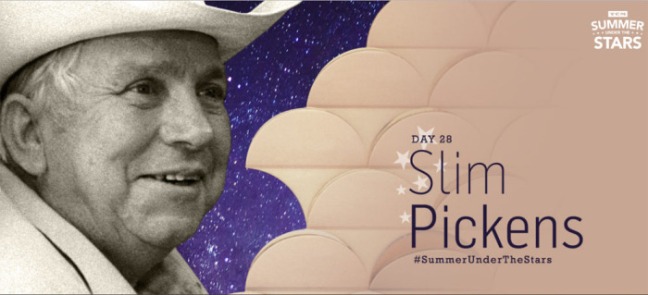
August 28 Entry in the 2017 TCM Summer Under the Stars Bloggathon, hosted by Journeys in Classic Film
We have a special guest star for this entry on the project, character actor Slim Pickens. The annual TCM Summer of Stars programming usually features the glamorous idols of the Golden Age of Hollywood; John Wayne, Ginger Rogers James Cagney and others. Once and a while, those scene stealers from a classic film will be featured. Actors like Charles Coburn, Thelma Ritter and Edward Everett Horton brought many program pictures to life with their unique presence. Character actors also make the leads look good when they are used in the right way. Like Strother Martin, our guest today is best known for his roles in Westerns, but has an iconic moment in a film that was not his primary oeuvre. What we are going to do today is start with the two films our guest and the subject of this blog have in common, then we will look at two roles that Slim Pickens is probably best known for, and finally we will finish up with a couple of performances that are most typical of his output.
The Slim Pickens/Strother Martin Crossovers
These two accomplished character actors appeared in only two films in common, at least as far as I could discover. The first of these is “The Flim-Flam Man” a 1967 comedy set in rural Georgia. George C. Scott is the star as Mordecai Jones, a legendary con artist who takes on Michael Sarrazin as an apprentice. The two of them have several escapes from locals that they have taken and there is a convoluted love story in the plot as well. Martin and Pickens are two of the rubes that the pair takes advantage of. Unfortunately they share no scenes with one another. Strother plays a storekeeper who buys an illegal punch out gambling board from Scott, at a bargain price, and then gets taken for all the prizes by Sarrazin.
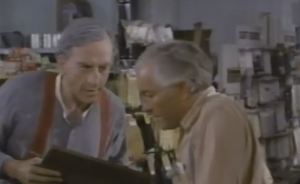
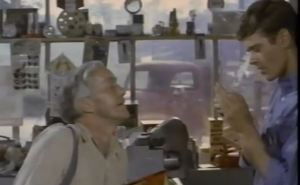
This sequence is only a couple of minutes long but it has the usual Strother Martin touch and George C. Scott hams it up throughout. Slim Pickens scene is only slightly longer but it occurs almost immediately after the previous con. Scott and Sarrazin see Pickens character exiting a bar, and Mordecai declares, “There’s our mark, a belt full of tobacco money and a belly full of beer”. 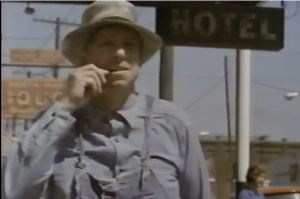
This con is a “pigeon drop”, similar to the con perpetuated by Robert Redford and Robert Earl Jones at the start of “The Sting”. Pickens is shown a lost wallet, Sarrazzin picks it up, and Scott swoops in with a solution to divvying up the money.
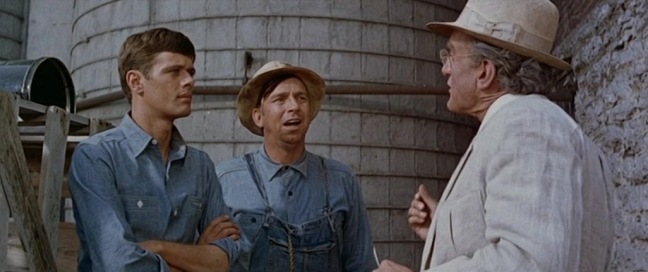
Slim sticks close to the caricature he is supposed to be playing, a greedy, belligerent hick who thinks he is going to take the other two but ends up losing his wad of cash. This is a role he plays much younger than most of his parts. Even when he was young, Slim Pickens seemed to be playing the wizened old hand. His distinctive voice and laconic delivery perfectly conveys the stereotype for this role.
The second film these two have in common is “The Ballad of Cable Hogue“.
This is a Sam Peckinpah film that was made right after the pivotal “The Wild Bunch”. Both Strother and Slim worked for Peckinpah several times in their careers. This may be a fairly odd film from the notorious director, It has the patina of a comedy and a gentle love story at it’s center, but ultimately it is about how revenge can distract you from what is important in life.
Jason Robards is Cable Hogue, a miner who is betrayed by his partners when they are stranded in the desert without enough water between them.
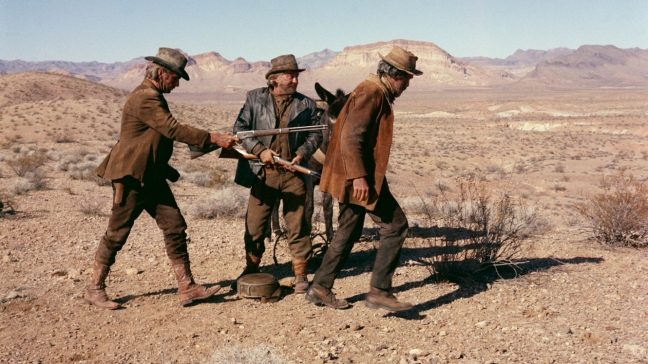
Strother plays Bowen, who along with his same partner from the Wild Bunch, L.Q.Jones as Taggart, leave Hogue in the desert while they sing a morose song about how they got the best of him. They even accuse him of being a coward because he did not shoot them when he had the chance. Hogue struggles for four days but ultimately finds water in a spot that no one believe water existed. Lucky for him it is also on the stagecoach trail and that is where Slim Pickens comes in. Pickens plays Ben Fairchild, the driver of the stage. When Hogue sets up a watering station on the road between two desert towns, Ben becomes a regular visitor. They also become friends and Pickens big scene is providing the Flag that Hogue sets up to mark the station for all kinds of travelers.
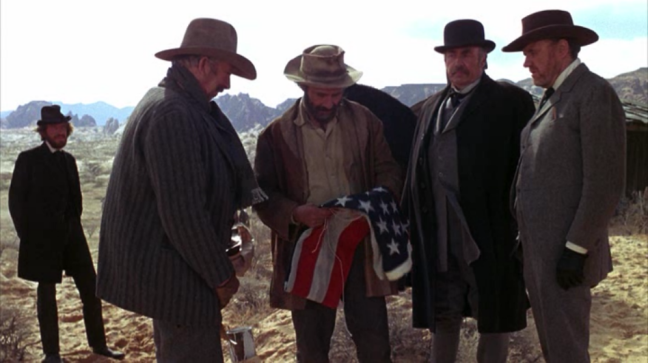
In the end of the story, Bowen and Taggart encounter Hogue once more but this time he has the drop on them. This is really the section where Strother get to do his thing. He is a truculent child who whimpers when circumstance go wrong for him. Slim and Strother have two brief scenes where they appear together but there is not much dialogue between them. Pickens is an avuncular cowboy who has made friends with the entrepreneur Cable Hogue. It’s not a major part but it is typical of the cowboys he usually played. 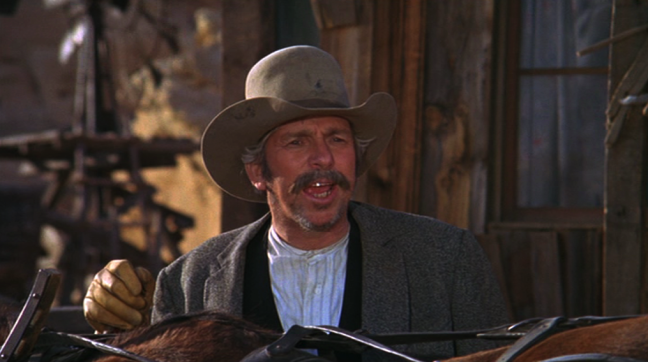
These two great actors have only three scenes together so it’s nice that we can enjoy them on the screen at the same time at least a little bit. Both of them would work with L.Q. Jones again and Strother would make another picture with co-star David Warner several years later. My favorite piece of trivia gleaned from the research I did on this post is that this was the only film that Slim Pickens brother appeared in. They had both worked in the rodeo circuit where they picked up their professional names. Slim was born Louis Lindley, and got the name Slim Pickins because that was all folks in the rodeo thought he was going to make. The trivia that I enjoyed is that his brother took the name “Easy. ”
Slim Pickens is listed Number 126 and Strother Martin Number 170 on an IMDB list of The Top 198 actors (supporting role) in the golden age of Hollywood.
Slim Pickens Best Known Roles
With more than a hundred and seventy credits in his filmography, it would be a monumental task to see all of his roles and try to give them some kind of ranking. It is however safe to say that if you were trying to identify Slim Pickens to someone unfamiliar with his name, there would be two films that would immediately be named for that person. Let me prove this to you, go to Google and on images, [or click here] type in his name. The first two images will be from these two movies.
Just as Strother Martin is well known for the quote from “Cool Hand Luke”, Slim Pickens is remembered for an image in a classic Stanley Kubrick film.
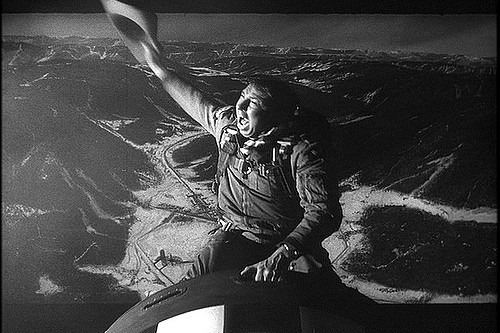
Major “King” Kong is the commander of the bomber group that heads off to blow up the Soviets in “Dr. Strangelove, or: How I Learned to Stop Worrying and Love the Bomb”. Originally, this character was to be a fourth part for Peter Sellars in the film. The story is that Sellars did not quite master the Texas accent and when he broke his ankle during production, Kubrick replaced him with Pickens. Slim saw only those parts of the script that involved his character and he played them straight without knowing the film was actually a comedy.
In addition to the “yahoo” as he rides the bomb to it’s destination, Pickens had several lines that are droll comments on military thinking. As he goes through a checklist of items in the planes survival kits he comments:
Major T. J. “King” Kong:
“Survival kit contents check. In them you’ll find: one forty-five caliber automatic; two boxes of ammunition; four days’ concentrated emergency rations; one drug issue containing antibiotics, morphine, vitamin pills, pep pills, sleeping pills, tranquilizer pills; one miniature combination Russian phrase book and Bible; one hundred dollars in rubles; one hundred dollars in gold; nine packs of chewing gum; one issue of prophylactics; three lipsticks; three pair of nylon stockings. Shoot, a fella’ could have a pretty good weekend in Vegas with all that stuff.”
Originally the city he named was Dallas, but after the assassination of President Kennedy, they looped in “Vegas” to avoid being insensitive.
Slim Pickens had worked regularly before this film, but after it’s release, he himself said his paychecks and dressing rooms got bigger. As an actor, he was largely cast to play himself. The character was modeled on a famous test pilot who did wear cowboy boots and sported a stetson but the accent and general demeanor were Pickens through and through. According to one story told about the shoot, James Earl Jones, who had a small part as a member of the crew, did not realize that Pickens wasn’t acting until he encountered him off camera and heard him speaking in the same voice as Kong.
The second role for which our subject is best known is as the ramrod cowboy henchman of Harvey Korman in “Blazing Saddles”. Taggart is the boss of the railroad crew who docks men’s pay when they pass out from the heat and values the hand truck more than the black railroad workers. When Clevon Little’s character Bart, swings a shovel at the back of Taggart’s head, the plot begins to thicken.
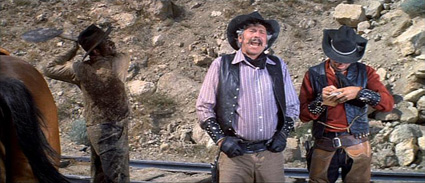
While sometime cast for comic effect, he was not perhaps well known as a comic actor. Pickens however did not just need a good line of dialogue to sell the humor in a film. This Mel Brooks farce gave him ample opportunity to show off his comic chops in a variety of ways. There are two great reaction shots that Taggart has that get as big a laugh as the material that sets it up. The first takes place in Hedley Lamar’s office, as Korman gets carried away with a small statue that is nude, Taggart notices and does the only thing an underling can do in that situation, he keeps his mouth closed and holds his nose. 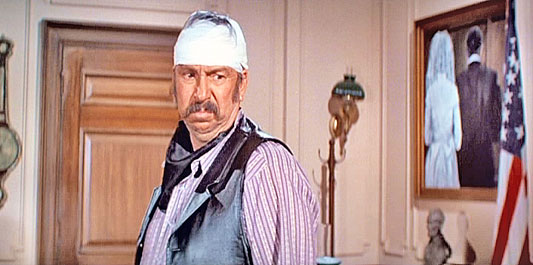
Speaking of holding his nose, in probably the most notorious scene in the film, as the audience is laughing at the sound effects and cowboys around the campfire, Pickens again gets a second chance to do a double take as he reacts to the atmospheric conditions surrounding his tent.
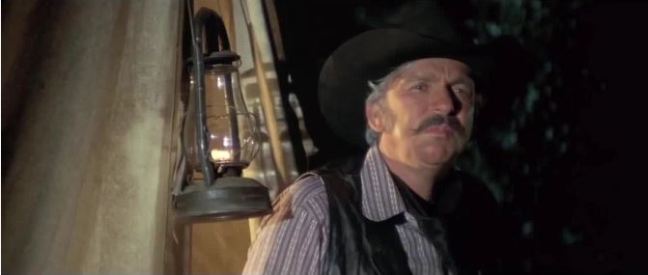
“I’d say you had enough” [Beans, for those of you who have never seen the film]
I’m sure everyone will agree that a film like this would probably not get made in today’s business. The language and situations that the Taggart character is involved with would raise so many to protest that he’d have to be cut from the film. There is the continued use of the “N” word by a racist character, done primarily for comic effect. You also have the suggestion that raping all the women would be a good time. To cap it off, his last scene involves abusing characters that are mincing homosexual stereotypes. Pickens lived and worked in a different world than exists today. I’m sure he’d just say
“Piss on you, I’m working for Mel Brooks.”
Assorted Additional Roles
There are three other films that I’d like to mention for various reason. The first is an example of Pickens being used sparingly but effectively because of type casting. Joe Dante’s “The Howling” is filled with character actors, most of whom have minor parts in the film. John Carradine shows up as a creepy old man [at this time he was in fact an old man]. Kevin McCarthy, a Dante favorite, is a news producer, Patrick McNee has a more substantial role as a psychologist, but guess what part Slim Pickens gets. If you guessed Sheriff, you should collect a prize. Out of the hundreds of film and TV roles Slim Pickens appeared in, he was a local Sheriff more often than any other type. His cowboy drawl probably accounts for the fact that even in a contemporary horror like this, he seems to be at home on the range, and Sheriff with a cowboy hat still works in in modern times.
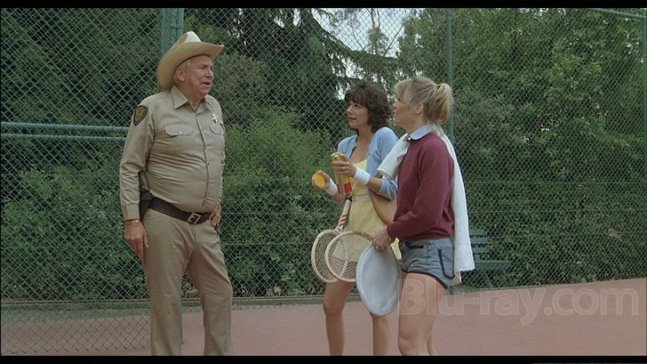
As I said, it’s not a major role but it is indicative of how Pickens was largely perceived by Hollywood. Even though he was usually cast as a peace officer, sometimes he played a good ole boy on the wrong side of the law. “White Line Fever” is a “B” movie from the 70s that was marketed based on the Citizen’s Band Radio craze of the time. Mob guys get a hold of the trucking business in the southwest and Pickens plays a flunky for another well known western actor L.Q. Jones. As a kid I always remembered that Pickens was in this film, but not because his performance was excellent. In fact it was one of the few times I felt as if he were phoning it in. The reason it made such an impression however is that Pickens character Duane Haller, is murdered by his bosses in a disturbing and unusual way.
Duane is lured out onto the open highway b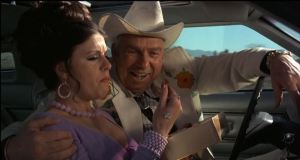 y a woman who works for the company as well. There, he is surrounded by three big rigs that force him to the side of the road. The thugs in the truck, drag him from his vehicle and then stretch him across the highway.
y a woman who works for the company as well. There, he is surrounded by three big rigs that force him to the side of the road. The thugs in the truck, drag him from his vehicle and then stretch him across the highway.
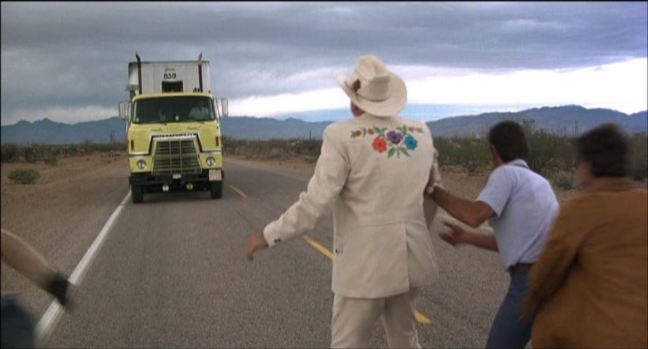
One of their trucks runs over Duane at very high speeds. It was a horrifying minute from a minor film but it was effectively staged with shots from behind the character, in front 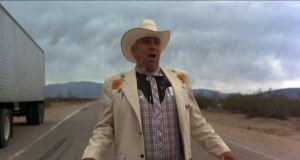 of the character and from above as the big rig runs him down. His distinctive costume and hat are briefly shown fluttering down the road after contact has been made.
of the character and from above as the big rig runs him down. His distinctive costume and hat are briefly shown fluttering down the road after contact has been made. 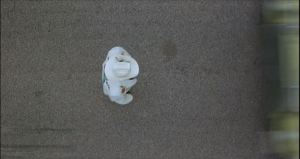 Pickens only gets a quick reaction shot but you can see from these pictures how well the scene played out.
Pickens only gets a quick reaction shot but you can see from these pictures how well the scene played out.
In the seventies, he worked frequently in big budget films and low budget features. A brief listing will give you some idea of how prolific he was: “The Getaway”, “Rancho DeLuxe”, “The Apple Dumpling Gang”, “The White Buffalo”, “The Swarm”, “Beyond the Posieden Adventure”, “1941”, and “The Black Hole” are just a few of the films he made and made better with his involvement.
In my view, his best on screen performance was in Sam Peckinpah’s “Pat Garrett and 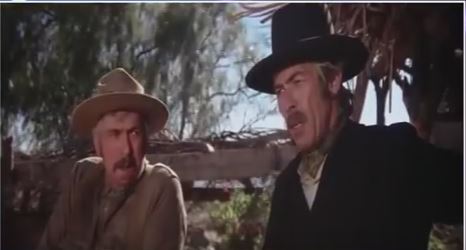 Billy the Kid”. Once again he was cast as a cowboy and a Sheriff, but he was a cantankerous lawman who claims that he will only cooperate with James Coburn’s Pat Garrett, if he gets paid. However, once he gets one of the Kid’s gang locked up and his wife who serves as a deputy joins him, he returns the gold dollar to Garret and rides out on a fateful mission.
Billy the Kid”. Once again he was cast as a cowboy and a Sheriff, but he was a cantankerous lawman who claims that he will only cooperate with James Coburn’s Pat Garrett, if he gets paid. However, once he gets one of the Kid’s gang locked up and his wife who serves as a deputy joins him, he returns the gold dollar to Garret and rides out on a fateful mission.
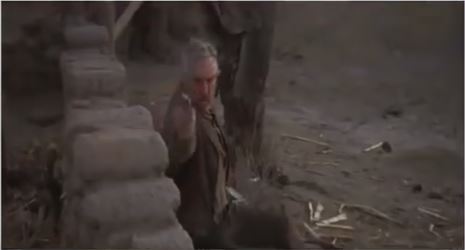
There is a shootout with the gang and most of them are killed, Sheriff Baker is mortally wounded and he walks over to the nearby river bank with his wife close behind and sits down to contemplate his life as he dies.
It is a wordless sequence that is made incredibly poignant by the presence on the soundtrack of Bob Dylan’s “Knockin on Heaven’s Door”, which was written for this film.
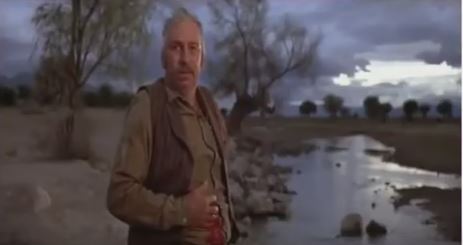
It is a heartbreaking moment and Pickens makes us feel the full weight of this loss without his trademark drawl. For the five minutes he is in this lengthy film, his moments are the most indelible ones, and they are a great example of the on screen impact that today’s TCM star had on the movies that he shone in.
The Shootout and aftermath can be watched here:

One thought on “TCM Summer Under the Stars Blogathon: Slim Pickens”